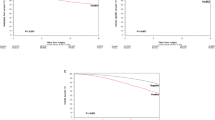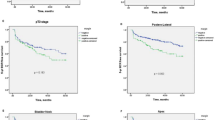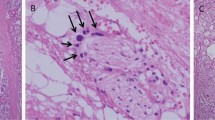Abstract
The aim of the study was to evaluate factors of progression after radical prostatectomy in patients with bladder neck invasion (BNI). From 1988 to 2006, 1395 patients underwent radical prostatectomy, 120 (8.6%) had microscopic BNI (pT4 N0, TNM 2002). Group 1 was defined as BNI alone, group 2 as BNI plus extracapsular extension and group 3 as BNI plus seminal vesicle invasion (SVI). Postoperative follow-up data were obtained through routine serum prostate-specific antigen (PSA) and digital rectal examination. Biochemical progression was defined as a single detectable PSA level postoperatively (>0.2 ng ml−1). Groups 1, 2 and 3 included 38 (31%), 35 (30%) and 47 (39%) patients, respectively. Preoperative PSA (11.1 vs 24.7 and 23.3 ng ml−1, P=0.01), biopsy Gleason score (5 vs 6 and 6, P=0.003) and specimen Gleason score (6 vs 7 and 7, P=0.02) were statistically different between three groups. None of the patients had a specimen Gleason score ⩾8 in group 1. After a mean follow-up of 27 months, 51 (42.5%) patients had biochemical progression. The 5-year progression-free survival was 87, 53 and 17% for groups 1, 2 and 3, respectively (P<0.001). Within pT4 prostate cancer, those tumors with isolated microscopic BNI appear to have better prognosis than those with associated extracapsular extension and/or seminal vesicle invasion, and should be distinguished in TNM classification.
This is a preview of subscription content, access via your institution
Access options
Subscribe to this journal
Receive 4 print issues and online access
$259.00 per year
only $64.75 per issue
Buy this article
- Purchase on Springer Link
- Instant access to full article PDF
Prices may be subject to local taxes which are calculated during checkout

Similar content being viewed by others
References
Verhagen PC, Tilanus MG, de Weger RA, van Moorselaar RJ, van den Tweel JG, Boon TA . Prognostic factors in localised prostate cancer with emphasis on the application of molecular techniques. Eur Urol 2002; 41: 363–371.
Salomon L, Anastasiadis AG, Johnson CW, McKiernan JM, Goluboff ET, Abbou CC et al. Seminal vesicle involvement after radical prostatectomy: predicting risk factors for progression. Urology 2003; 62: 304–309.
Greene FL, Page DL, Fleaming ID, Fritz A, Balch CM, Haller DG et al. American Joint Committee on Cancer, Manual for Staging Cancer, 6th edn. Springer: New York, NY, 2002.
Wheeler TM . Anatomic considerations in carcinoma of the prostate. Urol Clin North Am 1989; 16: 623–634.
Yossepowitch O, Engelstein D, Konichezky M, Sella A, Livne PM, Baniel J . Bladder neck involvement at radical prostatectomy: positive margins or advanced T4 disease? Urology 2000; 56: 448–452.
Yossepowitch O, Sircar K, Scardino PT, Ohori M, Kattan MW, Wheeler TM et al. Bladder neck involvement in pathological stage pT4 radical prostatectomy specimens is not an independent prognostic factor. J Urol 2002; 168: 2011–2015.
Dash A, Sanda MG, Yu M, Taylor JM, Fecko A, Rubin MA . Prostate cancer involving the bladder neck: recurrence-free survival and implications for AJCC staging modification. Urology 2002; 60: 276–280.
Aydin H, Tsuzuki T, Hernandez D, Walsh PC, Partin AW, Epstein JI . Positive proximal (bladder neck) margin at radical prostatectomy confers greater risk of biochemical progression. Urology 2004; 64: 551–555.
Poulos CK, Koch MO, Eble JN, Daggy JK, Cheng L . Bladder neck invasion is an independent predictor of prostate-specific antigen recurrence. Cancer 2004; 101: 1563–1568.
Acknowledgements
We thank Fundación Mexicana para la Salud for providing an educational grant to F Rodriguez-Covarrubias and J-F Grenot from the Créteil–Paris 12 Clinical Research Unit for his support.
Author information
Authors and Affiliations
Corresponding author
Additional information
Conflict of interest
None.
Rights and permissions
About this article
Cite this article
Rodriguez-Covarrubias, F., Larré, S., Dahan, M. et al. Invasion of bladder neck after radical prostatectomy: one definition for different outcomes. Prostate Cancer Prostatic Dis 11, 294–297 (2008). https://doi.org/10.1038/sj.pcan.4501009
Received:
Accepted:
Published:
Issue Date:
DOI: https://doi.org/10.1038/sj.pcan.4501009



